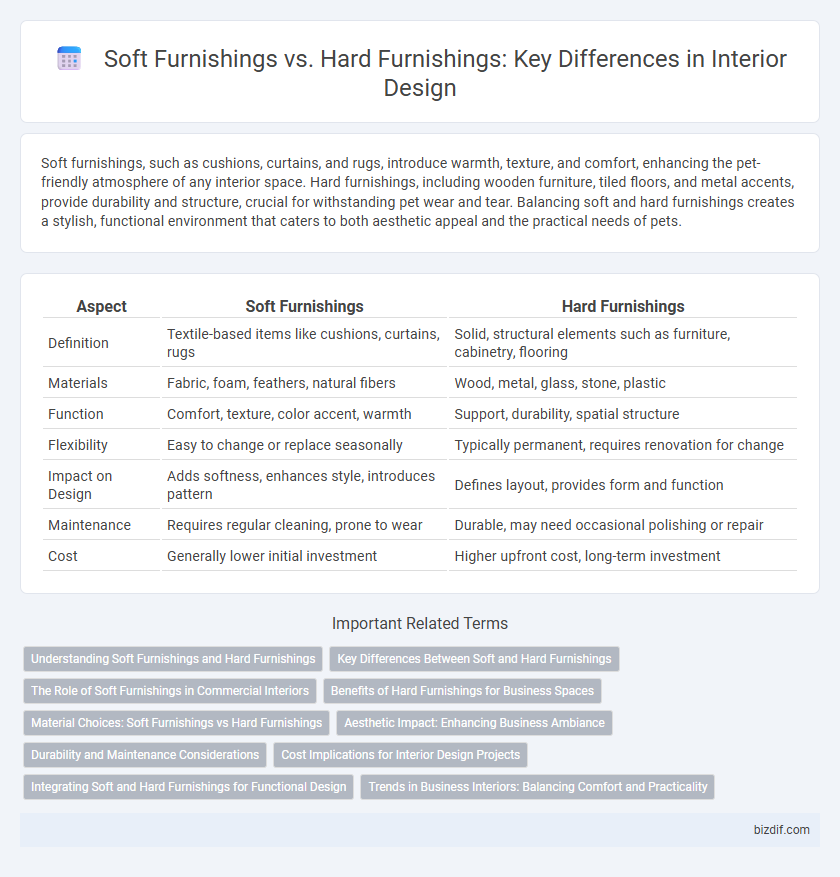Soft furnishings, such as cushions, curtains, and rugs, introduce warmth, texture, and comfort, enhancing the pet-friendly atmosphere of any interior space. Hard furnishings, including wooden furniture, tiled floors, and metal accents, provide durability and structure, crucial for withstanding pet wear and tear. Balancing soft and hard furnishings creates a stylish, functional environment that caters to both aesthetic appeal and the practical needs of pets.
Table of Comparison
| Aspect | Soft Furnishings | Hard Furnishings |
|---|---|---|
| Definition | Textile-based items like cushions, curtains, rugs | Solid, structural elements such as furniture, cabinetry, flooring |
| Materials | Fabric, foam, feathers, natural fibers | Wood, metal, glass, stone, plastic |
| Function | Comfort, texture, color accent, warmth | Support, durability, spatial structure |
| Flexibility | Easy to change or replace seasonally | Typically permanent, requires renovation for change |
| Impact on Design | Adds softness, enhances style, introduces pattern | Defines layout, provides form and function |
| Maintenance | Requires regular cleaning, prone to wear | Durable, may need occasional polishing or repair |
| Cost | Generally lower initial investment | Higher upfront cost, long-term investment |
Understanding Soft Furnishings and Hard Furnishings
Soft furnishings, including curtains, cushions, rugs, and upholstery, enhance comfort, texture, and warmth in interior spaces. Hard furnishings refer to fixed or semi-fixed elements like furniture, cabinetry, flooring, and built-in fixtures, providing structure and functionality. Both types significantly influence aesthetic appeal and spatial experience, often working together to create balanced, cohesive interior designs.
Key Differences Between Soft and Hard Furnishings
Soft furnishings encompass textiles like curtains, cushions, rugs, and upholstery that add warmth, texture, and comfort to interiors, while hard furnishings refer to permanent or semi-permanent elements such as furniture, cabinetry, and flooring that provide structure and durability. Soft furnishings are typically more flexible and easier to update or replace, influencing aesthetics and acoustics, whereas hard furnishings form the foundational framework of a space, contributing to functionality and spatial layout. Understanding the key differences helps designers balance tactile appeal with practical longevity in interior design projects.
The Role of Soft Furnishings in Commercial Interiors
Soft furnishings in commercial interiors--such as curtains, cushions, and upholstery--play a critical role in enhancing acoustics, comfort, and aesthetic appeal, contributing to a welcoming and productive environment. Unlike hard furnishings, these tactile elements absorb sound, improve indoor air quality, and allow for flexible design updates without structural alterations. Incorporating soft furnishings with ergonomic and sustainable materials supports employee well-being and aligns with modern workplace design trends focused on health and sustainability.
Benefits of Hard Furnishings for Business Spaces
Hard furnishings in business spaces enhance durability and require minimal maintenance, making them ideal for high-traffic areas. Their structural stability supports long-term investment by withstanding wear and tear better than soft furnishings. Integrating materials such as metal, wood, and glass contributes to a sleek, professional aesthetic while optimizing space functionality.
Material Choices: Soft Furnishings vs Hard Furnishings
Soft furnishings such as cushions, curtains, and upholstered furniture typically use materials like cotton, velvet, silk, and polyester blends, offering comfort, texture, and warmth to interiors. Hard furnishings, including tables, chairs, and cabinetry, utilize durable materials such as wood, metal, glass, and stone, providing structural support and aesthetic contrast. Selecting appropriate materials for both types balances tactile softness with visual solidity, enhancing the overall design harmony and functionality of indoor spaces.
Aesthetic Impact: Enhancing Business Ambiance
Soft furnishings like curtains, cushions, and rugs significantly elevate a business's aesthetic appeal by adding texture, color, and warmth that create an inviting atmosphere for clients and employees. Hard furnishings, including furniture, flooring, and fixtures, establish the structural style and visual foundation, contributing to a space's overall sophistication and coherence. Balancing both soft and hard furnishings optimizes the ambiance, fostering a professional environment that supports branding and customer experience.
Durability and Maintenance Considerations
Soft furnishings, such as cushions, curtains, and upholstery, require regular cleaning and upkeep to maintain their appearance and longevity, often needing vacuuming or professional cleaning to prevent fabric wear and stain buildup. Hard furnishings like wooden furniture, metal fixtures, and tiled surfaces offer greater durability and easier maintenance, typically requiring only occasional dusting, polishing, or wiping with suitable cleaners. The choice between soft and hard furnishings depends on balancing comfort and style with practical considerations of durability and cleaning effort in interior design.
Cost Implications for Interior Design Projects
Soft furnishings, including curtains, cushions, and upholstery, typically involve recurring expenses due to wear and seasonal updates, impacting long-term budgets in interior design projects. Hard furnishings, such as furniture frames, flooring, and built-in fixtures, often require significant initial investment but lower maintenance costs over time. Balancing these cost implications helps designers optimize project budgets while achieving desired aesthetics and durability.
Integrating Soft and Hard Furnishings for Functional Design
Integrating soft furnishings such as upholstery, cushions, and curtains with hard furnishings like furniture frames, cabinetry, and flooring creates a balanced and functional interior design. Soft furnishings add texture, color, and comfort, while hard furnishings provide structure, durability, and spatial definition. Combining these elements strategically enhances both the aesthetic appeal and usability of living spaces, ensuring a cohesive and practical environment.
Trends in Business Interiors: Balancing Comfort and Practicality
Soft furnishings such as cushions, curtains, and rugs are increasingly favored in business interiors for their ability to create a warm, inviting atmosphere that enhances employee well-being and productivity. Hard furnishings like desks and cabinetry remain essential for durability and functionality, often designed with sleek, modern materials that support ergonomic and space-efficient layouts. The latest trend emphasizes a strategic blend of both, using soft furnishings to introduce comfort and texture while relying on hard furnishings to maintain a professional, practical work environment.
soft furnishings vs hard furnishings Infographic

 bizdif.com
bizdif.com